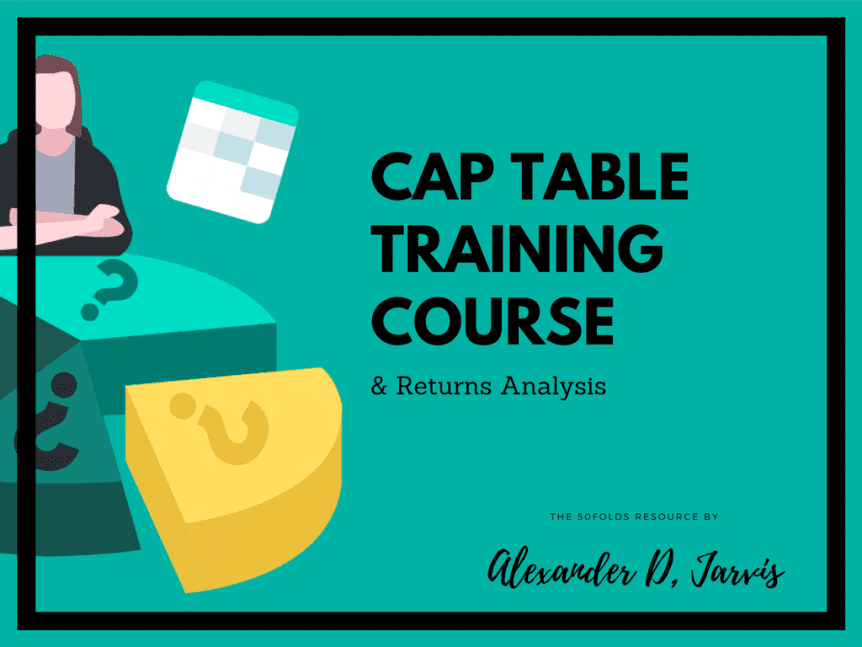This is the 3rd part of the Pro Cap Table training course. In this series we go through the basics you need to know, then work sheet by sheet so you know how to make a seriously kick ass cap table.
There are 14 parts:
- What is a cap table and other important questions
- Cap table dilution step by step example
- Cap table dilution math
- Starting the cap table (The drop down menus we need)
- Shareholders sheet
- Deal calculations
- The cap table sheet
- The assumptions sheet
- Individual shareholder returns sheet
- Returns waterfall calculation
- The ESOP sheet
- The Common sheet
- The convertible notes and warrants sheet
- The preference shares sheets (From Series A to I)
You can join the course and get these sent straight to your mail box here:
If you’re a dab hand at cap tables already, then you can skip this and head to the next edition.
If you’re not a boss at cap tables, then don’t skip this. You need to know how cap table dilution math works.
This is 101 math and you absolutely need to know it all off by heart. It gets harder from here and if you don’t know how this works you are going to struggle.
In the last course, we explained how dilution works at a high level, step by step. Now we need to explain things in terms of share prices. This can be a little confusing, but thinking in terms of share prices is a level up you need to do.
Let’s pretend you are doing a little seed deal. How does the math work?
Let’s start with pre-money and post-money valuations.
- Pre-money: The valuation post investment
- Post-money: The valuation after investment. This is simple the pre PLUS the investment
This is a little bit of a weird concept and I know a Partner at a VC that is confused by it. If you internalise that
- Post is the sum of pre and investment, you are off to a good start.
- Next, if an investor wants to put anything into the pre, that is bad. You want things to happen in the post. This is key!
Let’s do some numbers now.
You agree with investors that the pre is $4m and you are raising $1m in total. So your post is.. $5m!
Not you aren’t raising the $1m from just one investor: you are taking $750k from one and 250k from another.
- Pre: $4m +
- Investment: $750k + $250k =
- Post: $5m
So now to share price thingies.
You agree on a price per share implicitly when you agree to a pre valuation. This determines how much the investor will pay for their shares. You have shares before you raise money, right? Let’s assume that you have 8m shares already.
The px per share is the pre-money valuation divided by the number of pre-money shares. This means that:
- $4m / 8m shares = $0.50 per share
You have now agreed that the price per share of your company is valued at 50 cents.
How many shares do investors get for their money?
You divide the investment of the investors by the share price valuation we just calculated. This is therefore:
- $750k / $0.50 = 1.5m shares
And the other dude:
- $250k / $0.50 = 500k shares
So what, they have shares? Most people like to know what % they own right?
Take the shares we just calculated and divide by the total number of shares.
The total number of shares are:
- 8m we started with +
- 1.5m +
- 500k shares =
- 10m post-money shares
The large investor’s ownership is:
- 1.5m / 10m = 15%
The small investor:
- 500k / 10m = 5%
The total dilution from the seed round is 20%. All the previous shareholders were just diluted by 20%.
Here is a handy summary of all the key formulas that you need to know:
- Post-money valuation = Pre-money valuation + investment
- Price per share = Pre-money valuation / pre-money shares
- Post-money shares = Post money valuation/ price per share
- Investor ownership = Investor shares / post-money shares
There we go. Let’s get moving.
Click here to continue
Starting the cap tableShow off to your friends. Hit a social button to share the cap table love!

